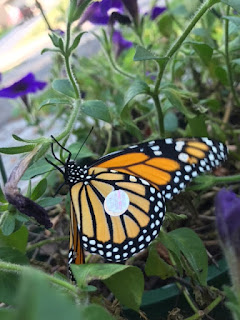So the question of the week is "How do you tag a Monarch?" Well, it's actually very easy, and apparently very effective. How many tags are placed on Monarchs each season, and how many are reported in Feb. and March? I have no way of knowing. There must be statistics that would answer that, but I'm not sure who would know. The tags I use are from Monarchwatch.org, which is an organization from Lawrence, Kansas I believe connected with Un. of Kansas. They are also my main information source about migration. According to this group the Leading edge of migrating Monarchs has reached Kansas and Missouri, so they are right on schedule for their journey to Mexico.
So back to the question "How do you tag a Monarch?" (see photos below) the tag is a very small sticker with a number on it. My tags are XUL201-XUL250. Each tag also has the Monarchwatch website listed on it, so if the butterfly is found in Mexico (or anywhere in between Minnesota and Mexico) the tag can be reported on the website with a location of findings. The tag is simply placed on the outside hind wing of the butterfly before release. So I will keep track of all my butterflies, male or female, and tag numbers. I should easily have tagged and released around 40 butterflies since Sept. 1, having raised about 75 this season.
So the final numbers are pretty impressive actually. I lost 3 caterpillars to the virus I mentioned in a previous blog, and I lost a few baby hatchlings just because they are extremely difficult to keep track of! So that puts my success rate at about 95%....those are much better odds than out in the wild. So again when people ask me "Why don't you just leave them outside?" The answer is a simple one. If a female Monarch lays 500 eggs, and only 10 or fewer of those eggs survive in the wild and I can give them a safer environment with a larger success rate than that, then I am helping the Monarch cause. I have also recruited friends and neighbors that are also helping the monarch, by helping me, or raising caterpillars and growing milkweed in their own yards. I figure that's about 100 Monarchs that might otherwise have perished without human help.
I just hope that the crazy weather that we are having doesn't have a negative effect on the population in Mexico, so that we have another good or better season next year. It will take several good seasons in order to revive the species so they are no longer in danger of extinction.
So for now I will continue my plight to SAVE THE MONARCH!! Carry on!

